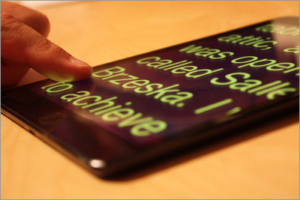Technology brings New Era for Readers with Disabilities
Written by Richard Orme
In 1868, four men gathered at 33 Cambridge Square in Hyde Park, London. The house was owned by Dr. Thomas Rhodes Armitage, a medical doctor who had retired from practice due to his failing eyesight. His guests that day were all blind, and they were meeting to discuss how to improve the availability of embossed books for people with sight loss.
The organization they founded, now the Royal National Institute of Blind People (RNIB), has since transcribed thousands of books and journals for people who are unable to read the standard print edition – volumes of braille, hours of talking books, pages of large print.
Despite this great effort, the majority of books and journals are not readily available in a form someone with sight loss can read easily. Charities like RNIB simply cannot keep up with the number of books and journals produced each year. People with sight loss have to wait for months for a book to become available, if ever. This situation also impacts other people with “print disability,” who are unable to use standard print editions. For example, this might be the inability to hold a book and turn the pages, due to physical disability.
Dr. Armitage embraced new ideas and approaches that improved the situation for blind people. He would certainly be thrilled to know that the digital publishing revolution and developments in consumer technology are heralding a time when people with print disabilities can read an unprecedented range of journals and books, for study and leisure.
A surge in e-books

Photo: Enlarged print on a tablet screen.
The UK is a nation of book lovers, with a vibrant and wonderful publishing industry. And like a growing number of countries, the British have taken to digital reading. Nearly one in five adult fiction books purchased last year (2012) were e-books. In March, about 24 percent of the adult population downloaded an e-book. Research conducted by Loughborough University for RNIB showed that 99 percent of popular adult fiction titles were published as e-books in 2012.
Many professional and academic texts are also released in electronic formats. For example, Elsevier publishes books in a variety of file formats, as well as on proprietary platforms such as ScienceDirect and MD Consult.
How people are reading e-books
Some people use dedicated e-readers to read e-books, but according to the 2013 edition of Consumer Attitudes Toward E-Book Reading, a publication of the Book Industry Study Group, people are increasingly reading with smartphones and tablets such as the iPad and Kindle Fire. While these devices are packed with complex technologies, the product segment demands a focus on ease of use and simplicity. And many of these smartphones and tablets come with built-in accessibility features to make them easier to use by people with disabilities.
How e-readers make books accessible
Accessibility features include the ability to increase the size of text and images. For someone who needs large print to read, this can be a revelation, as so few books are published in this format. The colors can usually be changed to suit a person’s requirements for their visual or cognitive condition. This can be of great benefit for someone with low vision, or with a cognitive reading impairment, as often a different color combination can be easier to read. E-books can also be read by a blind person using a feature where the text on the screen is spoken to them with a synthetic voice, or sent to a connected device that uses a matrix of plastic pins to form braille letters, to be read by touch. These accessibility features are available on tablet computers such as the iPad and Android tablets costing as little as £119 (about $192 or €140). And iPads and iPhones come with a built-in (free) text-to-speech capability called VoiceOver, which is very popular with people who are visually impaired.
At Elsevier, making books accessible for students

Photograph of Tripp Narup
Each year, Elsevier delivers over 4,000 titles in alternate formats for college students all over the world. Currently, the preferred format is PDF, but in the coming year, Elsevier will more widely offer the EPUB 3 format, which offers greater flexibility for readers with print disabilities.
The current PDF production process adds structural tags to the files, which makes them easier to use with text-to-speech applications. There are also simplified “alt text” tags for the illustrations.
Elsevier’s websites have also seen many improvements in the last few years, including applying the accessibility standards of the World Wide Web Consortium (W3C) to the HTML article pages.
Elsevier was a founding member of the AccessText Network, which helps college students with print disabilities obtain accessible versions of their textbooks and a participant in the Publisher Look-up Service in both the US and the UK.
— Tripp Narup, Global Archive Manager for Elsevier Health Sciences (St. Louis)
For more information about Elsevier’s approach to accessibility, see Elsevier’s accessibility policy.
The reading matter can come from a variety of sources. For consumer titles, Kindle books purchased from Amazon can be read on most tablet systems, and Apple has its iBooks bookstore. For the academic reader, books, chapters and articles from platforms such as ScienceDirect can be downloaded to a tablet and loaded into an app that offers the best experience for a reader’s needs.
When a title is unavailable
If something is not readily available, then many large publishers have a service where an electronic version can be provided to someone with a print disability on request, to be read on their device. If a student requires a text for studies, then often university libraries will request the electronic file on their behalf. In the UK the publisher lookup service helps educationalists source electronic formats of textbooks for students with disabilities. In the US, the Access Text Network connects disability service professionals to request files and to share files with other colleges and universities. And Bookshare, a US-based non-profit, has a library of over 200,000 titles for print-disabled people to download and read on a computer, smartphone or tablet.
So we have thousands of great books, technology companies doing some great innovation, and this offers people with difficulty in reading regular books the opportunity to access the same book, at the same time. That is a huge step forward to help people participate fully in education, to be successful at work, to hear a book review on the radio and be reading that title in braille within a few minutes, to read the same book as their book group with larger text, or to read a travel book and use text-to-speech to spell out the unfamiliar names of cities and places.B
More work to be done
We’re still near the beginning of this exciting new era. Whilst many publishers are digitizing their backlists, some older titles are not available in digital form. Some are stored as scanned images, which may be less useful than the print original. However, a well-produced digital file can deliver an experience with good navigation, text that reflows when enlarged, and images with descriptive captions. These features deliver a better experience for all readers; it’s why publishers are collaborating to adopt open standards such as EPUB that are efficient to produce but also have accessibility built right in. The EPUB standard has been developed by the International Digital Publishing Forum and is recommended by the International Publishers Association. A major goal of EPUB is to facilitate accessibility, and readers with disabilities will usually have the best experience if they are able to obtain a publication in this format.
Beyond producing the file, there are many other steps involved in getting a book from a publisher to a reader, and it isn’t uncommon for something to go wrong along the way, resulting in a poor experience. In the UK, the Publishers Association, Publishers Licensing Society, The Society of Authors and other key publishing organizations have called on everyone in the supply chain to play their part in making books accessible – from the authors of the books to the manufacturer of a device.
Not everybody who struggles to read will be able to use a tablet or smartphone. Complex scientific notation and highly graphical content cannot be read by everyone using current techniques. But some 145 years after that discussion in London, the accessibility features of smartphones and tablets, together with the explosion in the availability of digital books and articles, is bringing about a new era for reading for people with print disabilities.
Accessibility on ScienceDirect

Photograph of Ted Gies
Our Elsevier Accessibility Collaboration Group includes nine institutions from around the world that help test ScienceDirect web pages for usability, accessibility, and compatibility with assistive technology.
The modern accessibility best practices on ScienceDirect include MathML, an accessible math format, logical structure, and best practices for rich internet applications.
Also, ScienceDirect enables someone who is blind to bring up specialized menus to easily understand how a web page is organized and to jump around easily to different sections of a journal article, book chapter or the search interface.
JAWS screen reader can bring up a list of page sections, or “Landmarks,” on a ScienceDirect journal article. This feature helps a person who is blind to better understand the contents of a page and quickly jump to different sections.
Source: Elsevier

